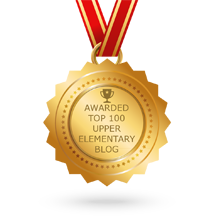If you've never played Two Truths and a Lie, it's about as simple as it gets. You write down three statements about yourself, but one of them isn't actually true. You then share your three statements with a partner or group and they determine which one is a lie. It's a fun and engaging way to get to know others.
The object, of course, is to write down statements that are convincing. When I do this activity, I tell students that they should think about activities they've done that are out of the ordinary, while also thinking about ordinary things that they didn't actually do. We discuss the fact that no one rode a rainbow on a magical unicorn and how writing something unrealistic like that would give their lie away.
This year, I'm going to kick this activity off with a read-aloud of the story The Truth About My Unbelievable Summer, a fun, exaggerated story of a child's summer vacation with fantastic illustrations. After I read this story, I plan to ask students to share the events in the story that made it unbelievable.
This will be my segue into Two Truths and a Lie. I will introduce the activity with some examples. Here's some I've used in the past:
- I rode the Superman roller coaster at Six Flags five times in a row.
- I ate a hot dog on the lawn of The White House.
- I swam with the dolphins in Hawaii.
- I ate frog legs at a French restaurant.
- I went horseback riding at the beach.
- I caught a 24 pound rainbow trout in Lake Tahoe.
- I coached cheerleading for five years.
I'll write my examples on the board (or add a slide with them for my back to school presentation) and ask students to think about each one. I'll call on a few students to share whether they think each of my statements is a truth or a lie and why. Students are usually surprised to find out that I'm not a strong swimmer (no swimming with the dolphins for this girl) and wouldn't catch a fish if you paid me. They are even more surprised to find out that I did spend a 4th of July at The White House. We will discuss why my statements were harder to determine than the events that were shared in our read-aloud. I will remind them that the book provided us a good example of the unbelievable, while my examples were more difficult to determine because they were all possible, even if some seemed less likely to be true than others.
After our discussion, students will work on their own statements. They will have about 10 minutes to work on this, and this work time will be at a level zero (no talking) since they will be sharing their statements with a partner or group when they are finished. Be prepared to help some students to generate ideas. As with all activities, this will come easier to some than others. You might want to prepare a list of additional examples in case anyone gets stuck for ideas.
Students will fold a paper in half the long way (hot dog style) and cut three flaps. They will write their three "truths" on the front and then under the flap of each one, they can check a box to show if it is a truth or lie (have them do this lightly or it will show right through the paper). When their work time is up, students can share their statements with a partner or group (depending on time constraints). Students can flip the flaps up to check their guesses after they've read them all. This activity will lead to great discussions and help to calm those first day jitters!
If you'd like to grab a copy of the reproducible that I use for Two Truths and a Lie, click the image below! Whether it's a couple of weeks, a month, or more, I hope your first week is fabulous!


















No comments